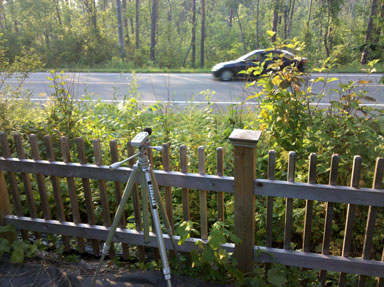July 19, 2011
Would you like to live on 13 or 366?
You may, like me, already live on a busy road, with cars, dump trucks, concrete mixers, buses, and tractor trailers going by. Or, you may live on one of Dryden's many peaceful roads, with only the occasional vehicle passing, or something in between.
If hydrofracking comes to Dryden, the noise distribution is going to change drastically. Many people who thought they lived in the middle of nowhere are going to have to deal with loud trucks passing their house for years.
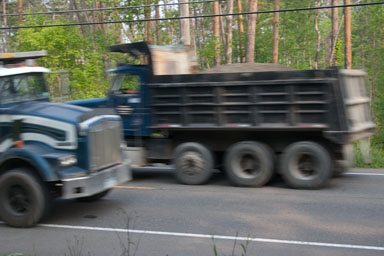
Gravel trucks passing on Route 366.
There was a while last month, I think at the peak of the Mount Varna filling, when trucks went by in a constant cycle from that parcel to RMS Gravel and Stinky's. Sometimes it was a truck every five minutes, sometimes it was a series of three going by at once. The road was suddenly a lot louder even than usual, substantially more noticeable inside my house (about 90 feet from the road.)
According to TCCOG's slides, part B (7.8MB PDF), page 12, The New York City Department of Environmental Protection estimates 1200 truck trips per well, while New York State suggests a range of 900 to 1300 trips. I suspect that terrain and the amount of fill needed to build a stable pad and supporting infrastructure is a lot of it, but the potential for repeated fracking to extend the life of the well also creates possible later bursts.
Each pad can have 8 to 12 wells, and I believe the state is limiting the rate of drilling to four wells per pad per year. That's a lot of trucks on their way to and from the pad, with a lot of reverse beepers at the pad, most likely.
This isn't your ordinary traffic, either. I've been experimenting with a decibel meter in front of my house, measuring sound levels at about 30 feet from the road.
The highest reading I've seen the meter record is 89.4 dB, a concrete truck passing loudly. Truck brakes can be much louder - fortunately I live on a straight stretch, and haven't had the meter out for one of those episodes. Today's peak was 87.4 dB.
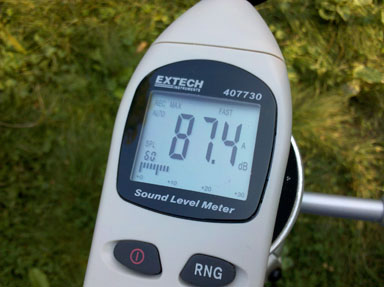
Today's peak: 87.4 decibels. (The low was happily unmeasurable, below 40 dB.)
Cars range from about 60-80 decibels, mostly depending on the state of their muffler and tires. Motorcycles range from about 50 to the low 80s, depending on how excited the owner is about loud pipes. Ordinary tractor trailers have been around 75-80, as are most buses. Above 80, it's pretty much always gravel trucks or concrete trucks. (An airplane flying low right over the house might manage these levels too, but they're usually around 75-80.)
Remember, the difference between 70 and 80 decibels isn't 14% louder - it's ten times louder. Every step of 10 decibels represents a multiplication by 10.
These noise levels aren't fun. It's extremely difficult to enjoy a front yard, at least with anyone you want to talk with, while this kind of traffic is passing, and even the back yard is difficult. Inside the house is okay, so long as I keep windows and doors that face the road closed. Cars passing at night, I'll admit, do help me go to sleep sometimes.
Let's take that loud and look at how it'll apply to the wells around Freeville.
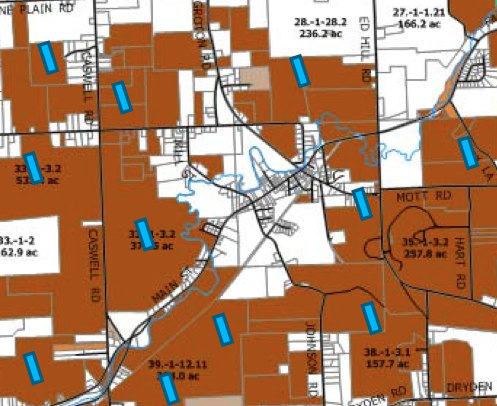
Possible well pads around the Village of Freeville.
Freeville already has a fair amount of heavy truck traffic because of RMS Gravel being just outside, and two of these pads aren't that far from RMS. (The Mott Road/366 intersection may get complicated, though.) That might at least reduce some truck traffic, though water, chemical, and other trucks will still have to come through. The Cady Lane well shouldn't have too many neighbors, but areas along 366 and Johnson Road will see a lot more truck traffic. West Dryden and (a fairly empty stretch of) Caswell Roads will be busy. The pad to the north of the village might make Brooklyn Road very busy, or that traffic might stay on Ed Hill Road, depending on where construction happens.
The traffic impact of drilling on the hillside above my house seems likely to be focused on Baker Hill Road and the short stretch of 366 connecting that to Route 13. Mount Pleasant Road might also see traffic, but has the same grades as Baker Hill Road combined with its own intersections, curves, and roller coaster sections.
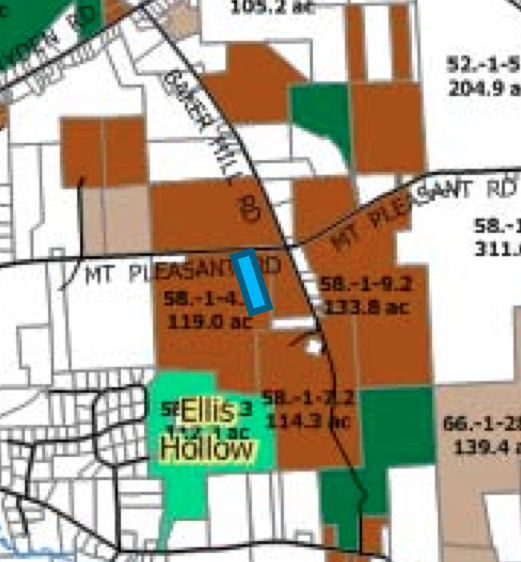
Possible well pad on the hillside above my house. (Note that Baker Hill Road doesn't actually connect Mount Pleasant and Eliis Hollow Creek roads.)
My bet, looking at the full map of the south of Dryden (274KB PDF), is that I won't personally have to deal with vastly more traffic than I already have. The few pads to my east are much further south, bringing these issues to residents of Snyder Hill Road and Route 79. It is, of course, possible for trucks to come up from Ithaca on Routes 79 and 366, but it's hard to imagine why truck drivers would want to do that. I suspect that those who do will be lost in the already substantial barrage of trucks carrying gravel and concrete to Ithaca for more traditional construction projects.
Even if you live on a state highway, though, you may want to take a look at the map (full map of the north of Dryden (270KB PDF) or full map of the south of Dryden (274KB PDF)) to get a sense of just how much noise and diesel exhaust is likely to be coming your way should fracking come to Dryden.
Update: This leaked transportation impact document brings some of this home as well, though more on a "what happens to my taxes?" level than a "what happens at my house?" level.
Posted by simon at July 19, 2011 7:25 PM in energy , noise , roads, traffic, and transitNote on photos
